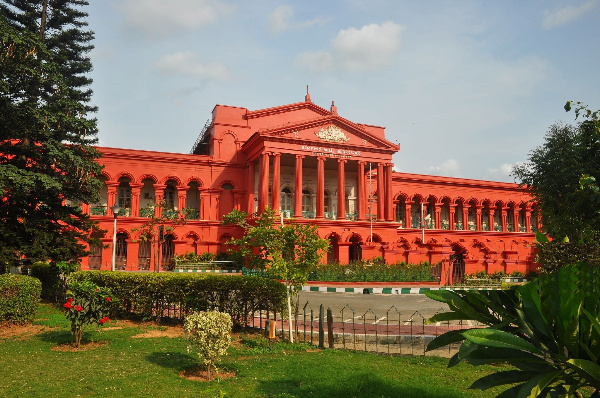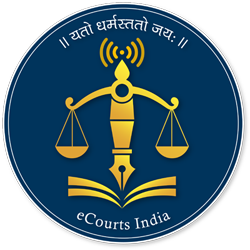History of HCK Bengaluru

HIGH COURT OF KARNATAKA, BENGALURU
On the green, sprawling lawns of Cubbon Park is the Attara Kacheri, which is the home of the High Court of Karnataka. It is in the heart of the City of Bangalore (now Bengaluru), opposite Vidhana Soudha, which houses the State Legislature, and the Secretariat. The road in between the pillars of democracy is aptly named ‘Ambedkar Veedhi’ in honour of Dr. B.R.Ambedkar, the architect of the Indian Constitution, clearly separating the Executive from the Judiciary.
Territorial Integrationof KarnatakaState:
A renowned American Judge and Jurist, Oliver Wendell Holmes Jr’s reflection that the law is its own experience holds true for the institutions that uphold the law.
Any study of the judicial institutions in the State of Karnataka would have to bear in mind three distinct territorial jurisdictions – erstwhile Mysore State Bombay – Karnataka area, and Hyderabad – Karnataka area. Added to this, are the coastal areas of Karnataka [Mangaluru region] and Coorg (Kodagu) which were part of the erstwhile British India. On re-organization of Karnataka State all the distinct territorial jurisdictions were merged to form Mysore State, which was renamed as Karnataka on 1 November 1973.
From Attara Kacheri to High Court of Karnataka – A Brief History:
The building in which the High Court at Bengaluru is functioning, called Attara Kacheri, has its own pristine glory. Literally, Attara Kacheri means “eighteen offices, or departments”, which originally comprised the general and revenue secretariat of the erstwhile Mysore State. It was also known as “Bowring’s Attara Kacheri” or “Old Public Offices”. When Mr. Lewin Bentham Bowring took over as Commissioner after Sir. Mark Cubbon, he conceived a full-fledged secretariat building in Bangalore which came to be known as Attara Kacheri, which eventually became the home of the State High Court. The Attara Kacheri was re-named as High Court of Mysore, in the year 1929. The administrative offices of the State continued to function in the Attara Kacheri till 1956, when they were shifted to Vidhana Soudha, which was constructed opposite Attara Kacheri under the leadership of Kengal Hanumanthaiah, then Chief Minister of Mysore State.
The building is unique in that all the three organs of the State of the erstwhile princely state of Mysore namely, the Executive, the Legislature and the Judiciary were all located in it. As noted above, even after independence, the building continued to retain its character till Vidhana Soudha was built.
Initially, administration of justice in erstwhile Mysore Princely State graduated from the locally confined Sadar Munsiff to the judges of the Huzur Adalath, and to the Judicial Commissioner of Mysore in 1856. The post was re-designated in the year 1881 as the Chief Judge, while the Court was renamed as the Chief Court of Mysore under Chief Court Regulation (1) of 1884, which was passed under Mysore Act of 1884 by Krishnaraja Wodeyar III on 28 May 1884. In a significant turning point in the judicial history of the state, the first Indian to be appointed as the Chief Judge was Rajadharma Pravina Shri.T.R.A. Thamboo Chetty, who was appointed to this Court in the year 1885.
The Court expanded its territorial jurisdiction beginning from the retrocession of the Civil and Military Station Area in Bangalore to the then Maharaja of Mysore, by Act XXIV of 1947, to the inclusion of the State of Coorg by Mysore High Court (Extension of Jurisdiction to Coorg) Act, 1952 and Bellary (now Ballari) district in the year 1953.
Concurrently, the Court also experienced changes in its jurisdiction. The Chief Court of Mysore was exercising both original, and appellate civil jurisdiction from 1884 to 1891. From 1891 to 1897- 98 it exercised only appellate jurisdiction on the civil side. Its original jurisdiction was again restored and it exercised such jurisdiction from 1898-99 to 1901-02. From 1 January 1903, the Chief Court (later the High Court) has not exercised any original civil jurisdiction. In the year 1908 the Sessions Court, Bangalore Division, was abolished. The Chief Court was invested with original criminal jurisdiction over the said Division, which was continued to be exercised till it was withdrawn with effect from 21 August 1911, when the Sessions Court, Bangalore Division, was re-established. There was a simultaneous effort to expand the Court in qualitative and quantitative terms as well. The number of Judges fixed at a minimum number of three under the Mysore Chief Court Regulation of 1884, was gradually increased over a period of time.
A resolution was tabled at the meeting of the Legislative Council held in December 1928 proposing that the Chief Court may be designated as “The High Court of Judicature of Mysore”. The Bill was introduced and after discussion, a final note was submitted by the Dewan of Mysore, Sir. Mirza M.Ismail, to Krishnaraja Wodeyar III, who approved the change as “High Court of Mysore” by his order dated 30 January 1929. Since then, High Court of Mysore exercised its jurisdiction over the former princely State of Mysore, and was continued as a High Court of Part-B State of Mysore till 26 January 1950 on which date, the Constitution of India was enforced. Thereafter, on the re-organization of States, in the year 1956, High Court of Mysore extended its jurisdiction to the entire State of Mysore which was re-named as State of Karnataka, with effect from 1 November 1973.
With the enactment of special statutes and the enlargement of jurisdiction, the Court witnessed a progressive increase in the work of the High Court, both on the judicial as well as on the administrative sides which necessitated an increase in strength over the years. In 1950, the number of Judges functioning were five. In the year 2005, thirty two permanent Judges, and eight additional Judges were handling nearly 1.4 lakh cases (both civil as well as criminal cases). Presently, the sanctioned strength of the High Court of Karnataka is 62 but the actual working strength is 48, handling 2, 40,240 cases.
On the agitation of the members of the Bar and public at Dharwad and surrounding Districts, a decision was taken to set up a Circuit Bench at Dharwad. A contemporaneous decision was also taken to set up a Circuit Bench at Gulbarga (now Kalaburagi) i.e., one at former Bombay – Karnataka region, and another in Hyderabad – Karnataka region. The Circuit Benches were made permanent Benches in the year 2013. The High Court at Bengaluru is now called as ‘Principal Bench of High Court of Karnataka’.
Golden Jubilee Celebrations: 2006-2007:
The Golden Jubilee Celebrations of the High Court of Karnataka having as its theme, “Justice for All: Real and Speedy” was held on completion of fifty years of the High Court since the re-organization of the State (1956). The Celebrations were inaugurated on 7th April 2006 by the then President of India Dr.A.P.J.Abdul Kalam. On 8th April 2006, about seventy out of eighty five former Judges of the High Court were felicitated and honoured, as also eighty advocates, who had completed fifty years of practice. Senior lawyers who had completed fifty years of practice in various Districts were also felicitated. Twenty seven former employees of High Court who had completed seventy five years were honoured and felicitated.
The first and third Saturday’s of the months from June to November 2006 were declared as working days in addition to the notified working days of the year, dedicated for hearing and disposing old cases.
Museum:
To commemorate the Golden Jubilee of the High Court, a Museum having a collection of artifacts and antique objects related to Courts having historical significance was inaugurated by Chief Justice Cyriac Joseph in 2006.
Epilogue:
The Attara Kacheri, which is the home of the High Court of State, is held in high esteem by the citizens of Karnataka for its untiring and continuous commitment, protecting and upholding their rights, as much as it is a grand architectural structure contributing to the cityscape of Bengaluru.
As a constitutional and appellate court, it has dealt with complicated questions of law in a manner that has paved the way for the march of the law, at the national level.
Judges and lawyers have discharged their respective roles with the highest intellectual and ethical standards.
The people of Karnataka look up to the High Court for not just vindicating their rights, liberties and freedoms but as an institution which renders justice to the people.


